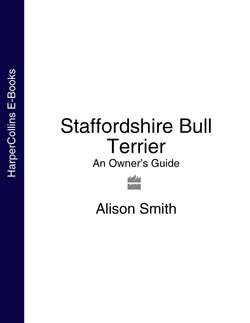Читать книгу Staffordshire Bull Terrier: An Owner’s Guide - Alison Smith - Страница 21
House-training
ОглавлениеIf done properly, house-training can be easy and stress-free for both you and your puppy. No puppy can avoid having the odd accident. He will have lived in a confined space for the first eight weeks of his life and will probably have relieved himself on newspaper. So don’t expect him to know automatically what to do straight away. You need to be patient.
In the very early stages, make sure that he is able to reach some newspaper (or a training pad) the minute he leaves his bed. He will be used to doing this, and any immediate change from his usual routine may cause him undue stress. It is ideal if his crate can be positioned as near to the outside door (the one he will go out of to relieve himself) as possible. This newspaper training will teach him not only to go in the same place all the time but will also help him to associate the back door with his toilet.
Always reward your puppy with praise words when he toilets outside in the garden.
During the first week, try and observe the times that he needs to toilet and start pre-empting him. Most puppies relieve themselves after a meal and on waking, so start off by taking him outside first thing in the morning. Don’t worry if he has already done something on his newspaper. Stand with him and let him toilet; maybe say a special word to get him used to the routine, such as ‘Be quick’. If he performs, make a fuss of him and praise him enthusiastically before taking him back inside. He will learn that toileting outside in a particular spot is rewarding and will want to please you.
Playtime
A Stafford puppy is happiest when he is playing. Until he has been fully vaccinated and is happy to walk on a lead, it is best to restrict his exercise to playtime with you in the garden and around the home.
Staffords love to tug things, so gentle tugs-of-war with a dog rope (available wherever dog toys can be obtained) are a good idea. Be careful with your puppy’s teeth though, and don’t be too boisterous at this stage. Let him chase toys that you throw for him and encourage him to run around the garden with you as well. If he is good, and particularly if he is gentle, reward his behaviour with a small dog treat and plenty of praise. Remember that at this age a puppy will tire very easily, so don’t expect too much from him: 10–15 minutes at a time are sufficient.
After a couple of weeks, he may go to the door himself and ask to be put out. Let him out and never stop using praise as this will reinforce that what he is doing is right. At this point, start telling him it is wrong to toilet inside. However, you must remain patient and not shout at your puppy. Make sure the door is open for him whenever possible. If you see him squatting down in readiness inside the house, use a single word command, such as ‘No’ or ‘Outside’, then pick him up and carry him outside. Praise him lavishly when he does his job.
This simple method will eventually produce the right result, but remember that accidents will happen occasionally, that a mixture of praise and commands will work, and that shouting will get you nowhere at all but will only frighten and confuse him. Be consistent and prepared to take your puppy outside 20 times a day if necessary, and you will soon have a dog who tells you when he needs the toilet – not the other way around.
It is best at this stage to stay outside with your puppy to make sure that he is doing his business, not just sneaking out of sight and pretending he has if the weather does not quite suit him.
Take advice from your breeder on feeding your Stafford puppy in the first few weeks.
